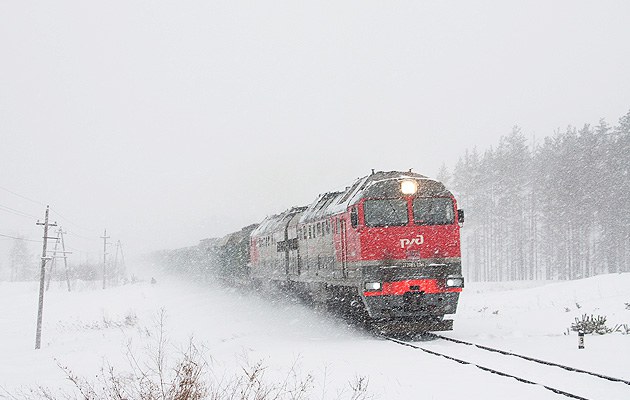
Stalin Did Not Succeed in Building Northern Railway and Neither Will Putin
Publication: Eurasia Daily Monitor Volume: 15 Issue: 22
By:

Throughout its history, Russia has faced a fundamental geographic problem: the rivers on which the country relies, both during shipping seasons and in winter-time as “ice roads,” flow almost exclusively from north to south rather than east to west. No Russian government has ever succeeded in building roads and railways east to west in the Far North, thus limiting the development of the northern third of the country. Not surprisingly, Moscow leaders have talked about the desirability of building roads and especially rail lines there for more than a century. But the difficulties confronting any such project have always been enormous and now are growing: global warming is melting the permafrost that underlies most of this region, making the ground more unstable than before. Indeed, giant methane bubbles rising from the depths are already destroying Russian infrastructure in the region (Siberian Times, July 4, 2017; (Windowoneurasia2.blogspot.com, July 5, 2017).
Seeing no other way forward, Russian leaders like Joseph Stalin in the 1940s and Vladimir Putin today now have repeatedly placed their hopes on the construction of just such a rail line. The Kremlin’s fear is that without reliable east-west transit lines in the Arctic and Far North, the Russian state will lose access to the wealth and security facilities there. The region is home to most of the country’s petroleum reserves as well as a large share of its military bases and missile sites. Thus, such a loss of access could eventually morph into a loss of political control as well. Moreover, leaders in Moscow have been convinced that giant projects like a northern railway will also bring other benefits: convincing Russians that their country is truly great, allowing the Kremlin to hand out benefits to its supporters, and distracting attention from the regime’s failure to build and maintain decent roads elsewhere.
During World War II, Stalin launched a secret project, code-named Site 501, to build what officials called “the Great Northern Rail Route.” He threw thousands of GULAG workers at the task, and approximately 900 kilometers of line were laid down, less than 10 percent of what would have been needed to realize his plans. But high costs and the shutting down of the prison labor system by his successors meant that, by the mid-1950s, the line had fallen into disuse; rails shifted or broke apart by the freezing and unfreezing of the ground, and the necessary bridges were left in a state of collapse. Stalin’s successors chose to focus on other means of penetrating the area, including the development of the Northern Sea Route (see EDM, April 29, 2016) and the rebuilding of Russia’s river fleet. However, these initiatives did not mean that Moscow ever entirely forgot about a rail line, especially since neither riverboats nor ice roads allowed the government to bring to the region the construction supplies it needed for other projects (Nstarikov.ru, February 11).
As a result of Russia’s earnings from oil during the first decade of the 21st century, Putin returned to this idea and even made it a centerpiece of his much-ballyhooed strategy document on developing the Russian rail grid up to 2030. According to the latest reports, in the last decade, Moscow has succeeded in laying down about 700 kilometers of rail line in the north, linking parts of the Yamal peninsula to the countrywide system. But these efforts utterly failed to meet either the amount Stalin’s GULAG workers built or any significant portion of the thousands of kilometers that would be needed to stretch from Murmansk to Chukotka (Pvo-info.ru, January 28).
Like most authoritarian leaders, Putin is not about to admit defeat: His government still calls for building the northern route. But Moscow’s actions in the last five years suggest that some in the Kremlin and many more in Moscow and in Russia’s regions have decided that, once again, such a rail line is not going to be built, however important they continue to say it is for the future of the Russian Federation. First, Moscow has placed more of its bets on the Northern Sea Route than on the northern rail corridor, opening new ports in the Arctic and hoping that it can supply by sea what it cannot bring in by rail or road (Cont.ws, February 4). Second, it has promoted the development of new off-road vehicles in the hopes that they can meet some of the demands for services in the high north (Izvestia, February 8). And third, it has continued to make use of ice roads, despite ever more frequent failures caused by warming temperatures (Siberian Times, January 12).
Building a rail line across the Russian North is possible but almost certainly beyond Russia’s financial capacity at this time. To keep it from breaking down almost immediately, its builders would have to put the kind of refrigeration units that underlie the Trans-Alaska pipeline from Point Barrow south—an enormously expensive proposition, requiring not only a large initial investment but also enormous and continuous supplies of energy. And even if the Russian state found the money for that, new studies show that the permafrost is melting far faster than anyone had predicted as recently as a decade ago. Indeed, a single methane bubble explosion would put any railroad and its support facilities out of service unexpectedly and for months at a time (Windowoneurasia2.blogspot.com, July 8, 2017; Siberian Times, July 4, 2017).
Consequently, there is no reason to think that Moscow will stop talking about building a northern rail line; but there is also no reason to believe that it will ever complete it.



